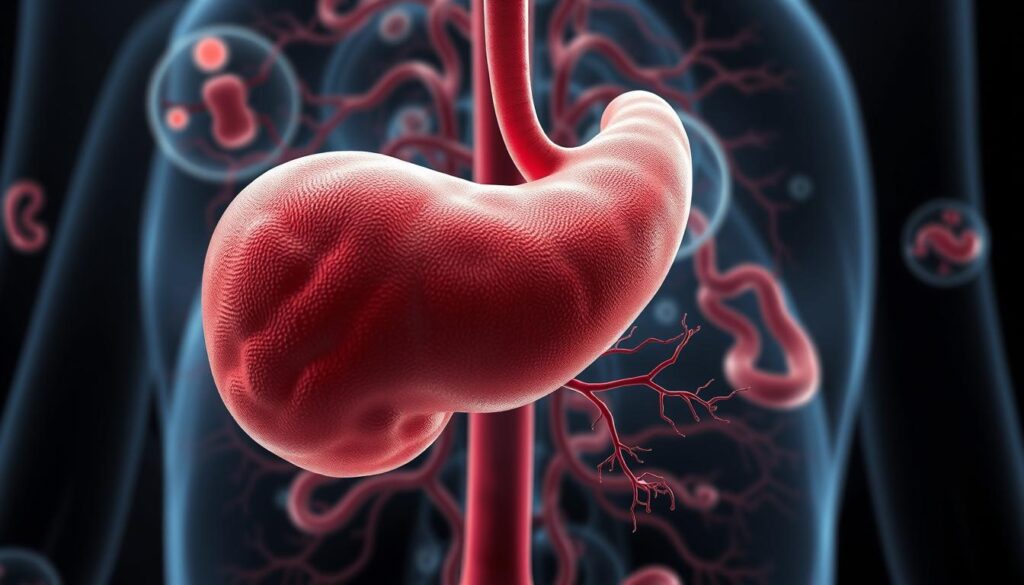Diabetes mellitus, or diabetes, is a chronic disease that affects millions globally. Over 133 million Americans have diabetes or prediabetes. You might wonder, what is diabetes mellitus? It’s when your body can’t make enough insulin or use it well. This leads to high blood sugar, or hyperglycemia.
Knowing about diabetes is key to managing it. If not managed, it can cause serious health problems.
Learning about diabetes mellitus shows it’s a complex issue. It affects not just your body but your overall health too. With the right knowledge and treatment, you can manage your diabetes and live a healthy life.
Key Takeaways
- Diabetes mellitus is a chronic disease that affects millions of people worldwide.
- The body’s inability to produce enough insulin or use it effectively results in high blood glucose levels.
- Understanding what is diabetes mellitus is crucial to managing the condition and preventing serious health complications.
- Diabetes definition is important to know, as it can help you understand the causes and effects of the condition on your body.
- Lifestyle modifications, including diet and exercise, can help manage diabetes and reduce the risk of complications.
- Diabetes mellitus is a serious condition that requires proper treatment and management to prevent long-term damage to your health.
- With the right knowledge and treatment, you can manage your diabetes and live a healthy life.
Table of Contents
What is Diabetes Mellitus: Understanding the Basics
Diabetes mellitus is a long-term condition. It affects how your body handles blood sugar, or glucose. The diabetes mellitus definition means you have too much blood sugar. This can cause serious health issues if not treated.
There are different types of diabetes. These include Type 1, Type 2, and Gestational diabetes. Each type has its own reasons and signs.
About 537 million adults worldwide have diabetes. This number is expected to grow to 643 million by 2030. In the U.S., about 1 in 10 adults have diabetes. Most of these cases are Type 2 diabetes.
It’s important to know the symptoms of diabetes. These include feeling very thirsty, needing to pee a lot, and feeling tired. Spotting these signs early can help get the right treatment.
The main types of diabetes are Type 1, Type 2, and Gestational diabetes. Type 1 is an autoimmune disease that needs insulin. Type 2 is linked to insulin resistance and lifestyle choices. Gestational diabetes happens during pregnancy.
Knowing the different types of diabetes and their causes is key. Recognizing the symptoms of diabetes and getting medical help early can help manage the condition. This can prevent serious problems later on.
Some important facts about diabetes include:
- Approximately 1 in 11 adults worldwide has diabetes mellitus (DM)
- 90% of people with diabetes have Type 2 diabetes mellitus (T2DM)
- The prevalence of diabetes is increasing globally, with projections suggesting a rise to 642 million by 2040

Different Types of Diabetes and Their Causes
Diabetes mellitus is a group of diseases with high blood sugar levels. There are three main types: Type 1, Type 2, and gestational diabetes. Each type has its own causes, symptoms, and treatments. Types of diabetes vary based on their causes, from autoimmune responses to insulin resistance.
Understanding diabetes mellitus means knowing each type’s unique traits. Type 1 diabetes is when the body attacks its own insulin-making cells. Type 2 diabetes makes the body resistant to insulin. Gestational diabetes happens during pregnancy and usually goes away after birth.
Knowing the diabetes causes and traits of each type is key for managing it. Here are important points to remember:
- Type 1 diabetes often starts in children and young adults, but can start at any age.
- Type 2 diabetes takes years to develop, with many people not noticing symptoms or only mild ones.
- Gestational diabetes usually has no symptoms, but may include increased thirst and urination if present.
It’s crucial to know the different types of diabetes and their diabetes causes for proper care. By understanding each type’s unique features, you can create a personalized plan with your healthcare provider to manage diabetes mellitus.
| Type of Diabetes | Description | Causes |
|---|---|---|
| Type 1 | Autoimmune condition | Immune system attacks insulin-producing cells |
| Type 2 | Insulin resistance | Body becomes resistant to insulin |
| Gestational | Occurs during pregnancy | Hormonal changes and insulin resistance |
Recognizing Common Symptoms and Warning Signs
Learning about diabetes is key. It’s important to know the common symptoms and warning signs. These signs can be small but are crucial for spotting the condition early.
Excessive thirst, frequent urination, and fatigue are signs of possible blood sugar imbalances. Knowing these symptoms of diabetes helps in creating a good prevention and management plan. Each person may show different diabetes warning signs. Common ones include increased thirst, fatigue, blurry vision, and slow wound healing.
Also, diabetes risk factors like family history, obesity, and not being active can raise your risk. The American Diabetes Association says family history is a big risk factor. Being overweight makes you three times more likely to get type 2 diabetes. Knowing these diabetes risk factors and taking steps to prevent or manage diabetes is crucial.
- Excessive thirst and hunger
- Frequent urination
- Fatigue
- Blurred vision
- Slow wound healing
It’s vital to recognize these diabetes warning signs and get medical help if you notice them. Early detection and treatment can prevent serious problems and improve your health.
| Diabetes Type | Symptoms | Risk Factors |
|---|---|---|
| Type 1 Diabetes | Rapid onset, excessive thirst, frequent urination | Family history, genetic predisposition |
| Type 2 Diabetes | Gradual onset, increased thirst, fatigue | Obesity, physical inactivity, family history |

Diagnosis and Medical Assessment Methods
Understanding diabetes diagnosis is key. The American Diabetes Association says testing blood glucose levels is crucial. You might have a fasting blood sugar test, an oral glucose tolerance test, or an HbA1c test. These tests help figure out if you have diabetes or prediabetes.
A diabetes assessment might include one or more tests:
- Fasting blood sugar test: checks blood glucose after fasting overnight
- Oral glucose tolerance test: checks blood glucose after drinking a sugary drink
- HbA1c test: shows average blood glucose levels over 2-3 months
Knowing your test results is important for managing your diabetes. For example, an HbA1c of 6.5% or higher on two tests means you have diabetes. Levels between 5.7% and 6.4% mean you have prediabetes. Diabetes testing is key to managing the disease and avoiding serious problems.
Your doctor might also suggest regular diabetes assessment to keep an eye on your health. This could mean tracking your blood sugar, watching your diet and exercise, and changing your medicine if needed.
| Test | Result | Indication |
|---|---|---|
| HbA1c | 6.5% or higher | Diabetes |
| HbA1c | 5.7-6.4% | Prediabetes |
| Fasting blood sugar | 126 mg/dL or higher | Diabetes |
Treatment Options and Management Strategies
Managing diabetes needs a full plan. This includes diet, exercise, and medicine. Losing weight and eating right can really help.
Being active is also key. Taking your medicine, getting education, and keeping doctor’s appointments are important too.
Managing diabetes means many things. This includes checking blood sugar, using insulin, and making lifestyle changes. Working with a healthcare team is crucial.
This team should include a doctor, nurse, and dietitian. They help create a plan that fits your health needs and goals. This might include keeping a healthy weight and managing blood pressure.
- Monitoring blood glucose levels regularly
- Taking diabetes medication as prescribed
- Engaging in regular physical activity, such as walking or exercise
- Eating a healthy, balanced diet
- Managing stress and getting enough sleep
By following these steps and working with your healthcare team, you can manage diabetes well. This helps lower the risk of serious problems.
Living with Diabetes: Lifestyle Modifications
When living with diabetes, making lifestyle changes is key. A diabetes lifestyle includes a healthy diet, regular exercise, and managing stress. These steps help avoid serious problems.
A diabetes diet should have lots of veggies, fruits, and whole grains. Avoid sugary drinks, fats, and white carbs. The American Diabetes Association says this diet helps control blood sugar.
Regular exercise is also vital. Try to do 150 minutes of moderate activity or 75 minutes of hard activity each week.
Dietary Guidelines and Meal Planning
A good diabetes diet helps keep blood sugar in check. Here are some tips:
- Eat lots of whole foods like veggies, fruits, and grains
- Stay away from sugary drinks, fats, and white carbs
- Choose lean proteins like chicken, fish, and beans
Exercise and Physical Activity Recommendations
Exercise is key for diabetes management. Aim for 150 minutes of moderate or 75 minutes of hard activity weekly. Here are some ideas:
- Brisk walking
- Swimming
- Cycling
Stress Management and Mental Health
Stress and mental health are important for diabetes care. Here are some tips:
- Try stress-reducing activities like meditation or deep breathing
- Make sure to get enough sleep
- Stay close to friends and family
Conclusion: Taking Control of Your Diabetes Journey
Diabetes mellitus is a complex condition that needs careful management to keep you healthy. By learning about this chronic disease, spotting early signs, and making a good diabetes plan, you can manage your diabetes. This helps lower your risk of serious problems.
The International Diabetes Federation (IDF) says about 463 million adults worldwide had diabetes in 2019. They think this number could hit 700 million by 2045 if we don’t act fast. This shows how important it is for people to manage their diabetes and make lifestyle changes to stop it from getting worse.
Your healthcare team is key in managing your diabetes. Work with your doctor to create a treatment plan that’s just for you. Keep an eye on your blood sugar and adjust your lifestyle as needed. By being active in your health, you can get better results and live a better life.
FAQ
What is diabetes mellitus?
Diabetes mellitus is a long-term condition. It affects how the body handles blood sugar. It happens when the body can’t make enough insulin or use it well.
What are the different types of diabetes?
There are three main types of diabetes. Type 1 is when the body attacks insulin-making cells. Type 2 is when the body can’t use insulin well. Gestational diabetes happens during pregnancy and goes away after birth.
What are the common symptoms of diabetes?
Symptoms include being very thirsty, needing to pee a lot, feeling tired, blurry vision, and slow healing. These signs are important to notice.
How is diabetes diagnosed?
Doctors test blood sugar levels to diagnose diabetes. They use fasting blood sugar tests, oral glucose tolerance tests, and HbA1c tests. Knowing these tests helps manage diabetes.
How is diabetes treated?
Treatment includes medication, insulin, and lifestyle changes. Medication and insulin control blood sugar. Healthy eating and exercise help manage the condition.
What lifestyle changes can help manage diabetes?
Eating right, staying active, and keeping a healthy weight are key. A good meal plan and exercise routine help. Stress management is also important.
How useful was this post?
Click on a star to rate it!
Share this article:
Meet Gluco 6
Blood sugar balance supplement
Tired of Type-2 controlling your life or worried that persistent high blood sugar may turn into something worse? Then yes, Gluco6 is right for you.
Gluco6 has already provided amazing blood sugar assistance for men and women in their 30s, 40, 50s and even 80s. Because it was formulated based on cutting-edge science and groundbreaking ingredients, Gluco6 is engineered to rapidly assist even the most erratic blood sugar levels.





